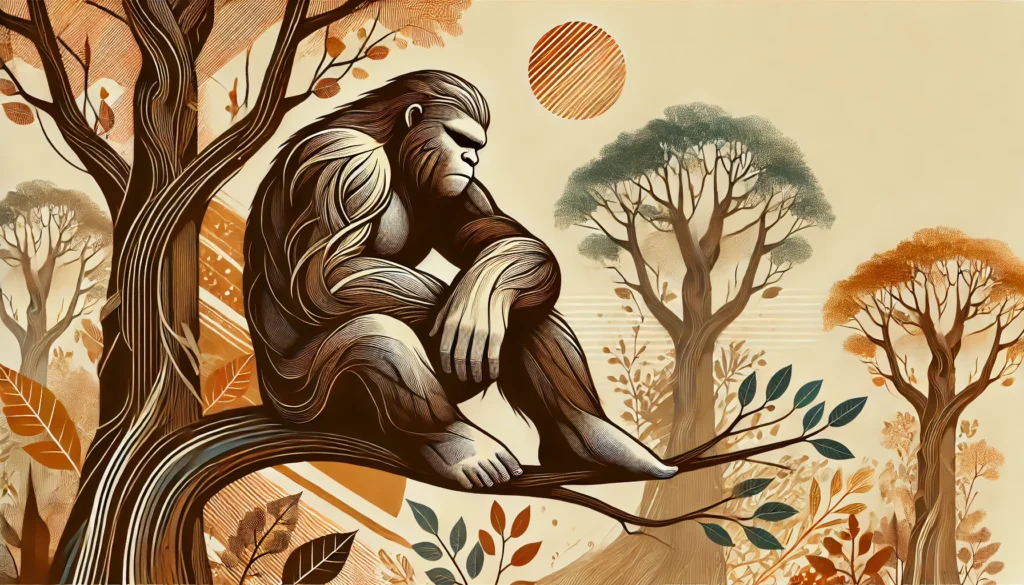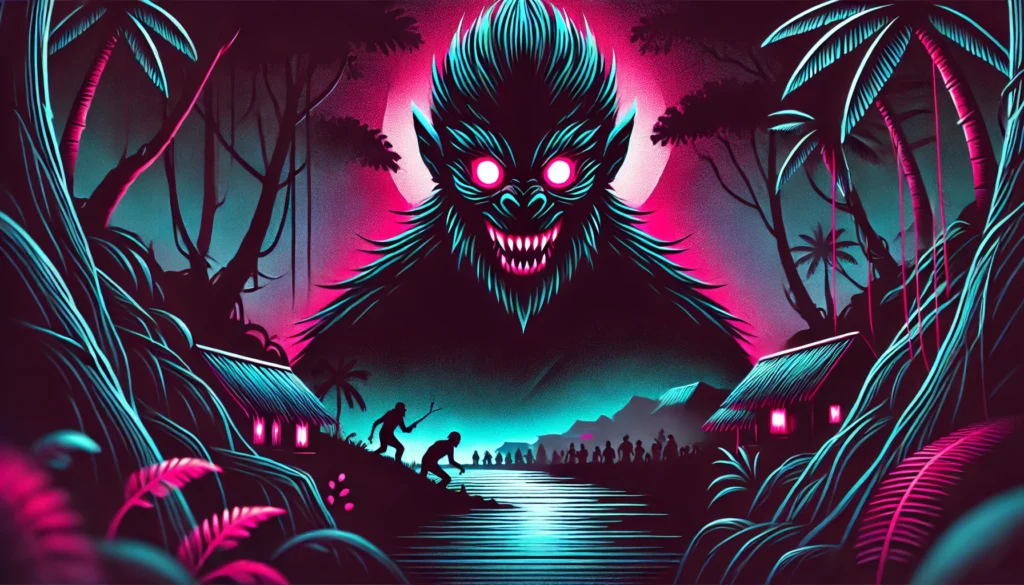Have you ever felt a strange presence while walking through a dense forest? Or perhaps you’ve heard whispers of giant, tree-dwelling creatures in Filipino folklore? Welcome to the fascinating world of the Kapre, a mythical being that has captured the imagination of generations and found its way into the heart of literature. As someone who’s always been drawn to the intersection of myth and reality, I’ve spent years delving into the rich tapestry of stories surrounding these enigmatic creatures. Today, I’m excited to take you on a journey through the realm of Kapre in literature, exploring how these beings serve as powerful symbols for our relationship with nature and our own humanity.
The Origins of Kapre: From Folklore to Fiction
A Brief History of the Kapre Myth
Before we dive into the literary representations of Kapre, let’s take a moment to understand their origins. Kapre are deeply rooted in Filipino folklore, with stories of these creatures dating back centuries. Typically described as tall, dark-skinned, hairy giants who dwell in large trees, Kapre are often portrayed smoking large cigars or pipes. While they can be mischievous, they’re generally considered gentle giants unless provoked.
The Kapre myth likely originated during the pre-colonial period in the Philippines, evolving over time as different cultural influences shaped the archipelago. Some scholars suggest that the concept of Kapre may have been influenced by early encounters with dark-skinned indigenous peoples or even by memories of now-extinct giant apes that once roamed Southeast Asia. Regardless of their exact origins, Kapre have become an integral part of Filipino mythology and have since found their way into various forms of literature.
From Oral Tradition to Written Word
The transition of Kapre from oral folklore to written literature is a fascinating journey in itself. As Filipino authors began to explore their cultural heritage in the written form, Kapre emerged as powerful symbols and characters in their stories. This shift allowed for a deeper exploration of the themes associated with these mythical beings, moving beyond simple cautionary tales to complex narratives that reflect on the human condition and our relationship with the natural world.
Early written accounts of Kapre can be found in collections of Filipino folklore compiled by anthropologists and folklorists in the late 19th and early 20th centuries. These compilations served as a bridge between oral traditions and modern literature, preserving the essence of Kapre stories while introducing them to a wider audience.
Kapre as Guardians of Nature: Environmental Themes in Literature
Protectors of the Forest
One of the most prevalent themes in Kapre literature is their role as guardians of nature. Many stories depict Kapre as fierce protectors of their forest homes, standing against human encroachment and environmental destruction. This portrayal resonates deeply with me, as it reflects our own growing awareness of the need to protect our natural world.
In novels like “The Last Kapre” by Rene O. Villanueva, we see Kapre as the last line of defense against deforestation. The story follows a young boy who befriends a Kapre and learns about the importance of preserving the forest. Through this narrative, Villanueva masterfully weaves together environmental messages with the rich tapestry of Filipino mythology, creating a powerful call to action for readers of all ages.
Symbols of Biodiversity
Another fascinating aspect of Kapre in literature is their representation of biodiversity. Authors often use the mysterious and elusive nature of Kapre to highlight the importance of preserving unknown species and ecosystems. This theme is particularly poignant in an age where we’re constantly discovering new species while simultaneously losing others to extinction.
The short story collection “Spirits of the Forest” by Maria Elena Paterno explores this concept beautifully. In one tale, a group of scientists searching for undiscovered species encounters a Kapre, leading to a profound reflection on the limits of human knowledge and the vast mysteries still hidden in our world’s forests.
The Human Side of Kapre: Exploring Identity and Otherness
Outsiders and Outcasts
While Kapre are often portrayed as nature spirits, many authors use them as a lens to explore themes of identity and otherness. As beings that straddle the line between human and supernatural, Kapre serve as perfect metaphors for those who feel out of place in society.
In the novel “The Kapre’s Daughter” by Cyan Abad-Jugo, we follow the story of a young girl who discovers her Kapre heritage. The book delves deep into issues of belonging, cultural identity, and the struggle to find one’s place in a world that doesn’t quite understand you. As someone who has often felt like an outsider, this theme resonates strongly with me and I believe it’s a universal experience that many readers can connect with.
Bridging Cultures
Kapre stories also often serve as a bridge between traditional Filipino culture and the modern world. Many contemporary authors use Kapre as a way to explore the tension between old beliefs and new realities, creating narratives that speak to the complexities of cultural evolution.
The award-winning young adult novel “Tree of Secrets” by Ryan Cayabyab is a prime example of this. Set in a rapidly modernizing Manila, the story follows a teenager who discovers a Kapre living in an ancient tree scheduled for removal. As the protagonist fights to save the tree and its inhabitant, she also grapples with her own cultural identity and the value of preserving tradition in a changing world.
Kapre in Different Literary Genres: A Versatile Symbol
Fantasy and Magical Realism
It’s no surprise that Kapre feature prominently in fantasy and magical realism literature. Their supernatural nature makes them perfect characters for stories that blur the lines between reality and imagination. In these genres, Kapre often serve as guides or mentors, helping human characters navigate between the mundane and magical worlds.
One of my favorite examples is the novel “The Smoke Tree” by Mia Alvar. In this beautifully crafted work of magical realism, a Kapre becomes an unlikely ally to a grieving widow, helping her come to terms with loss while also protecting her from darker supernatural forces. Alvar’s deft handling of the Kapre mythology creates a story that is both deeply rooted in Filipino culture and universally relatable.
Horror and Suspense
While Kapre are often portrayed as benevolent or neutral beings, some authors have tapped into their more mysterious and potentially frightening aspects to create compelling horror and suspense stories. These tales often play on the fear of the unknown and the dark secrets that might lurk in the depths of the forest.
The anthology “Monsters of Manila” edited by Paolo Chikiamco features several chilling Kapre-centric stories. One particularly memorable tale, “The Cigar” by Eliza Victoria, subverts the traditional Kapre myth by presenting a malevolent entity that preys on human fears and weaknesses. These darker interpretations of Kapre mythology add depth and complexity to their literary representation.
Children’s Literature
Kapre have also found a special place in children’s literature, where they often appear as gentle giants who teach valuable lessons about nature, friendship, and courage. These stories play a crucial role in introducing young readers to Filipino mythology while also imparting important moral and environmental messages.
The picture book series “Kapre Kiko’s Adventures” by Segundo Matias Jr. has been particularly successful in bringing Kapre to a younger audience. Through colorful illustrations and simple yet engaging stories, Matias introduces children to the concept of Kapre while weaving in lessons about kindness, respect for nature, and the importance of preserving cultural heritage.
Literary Techniques in Kapre Stories: Crafting Compelling Narratives
Symbolism and Metaphor
One of the most powerful aspects of Kapre in literature is their rich symbolic potential. Authors often use Kapre as metaphors for various aspects of the human experience or as symbols of nature’s power and mystery. This layered approach to storytelling allows for deep, meaningful narratives that resonate on multiple levels.
For instance, in the poem cycle “Whispers of the Balete” by Merlie Alunan, the Kapre serves as a complex symbol representing both the enduring spirit of nature and the fading traditions of rural Philippines. Alunan’s evocative imagery and skillful use of metaphor create a haunting meditation on change, loss, and the enduring power of myth.
Point of View and Narrative Voice
Another interesting aspect of Kapre literature is the diverse range of narrative perspectives employed by authors. Some stories are told from the point of view of humans encountering Kapre, while others daringly adopt the Kapre’s perspective, offering a unique and often thought-provoking view of the human world.
The short story “Through Kapre Eyes” by Miguel Syjuco is a masterful example of the latter approach. By narrating the tale from a Kapre’s perspective, Syjuco creates a powerful commentary on human behavior and our impact on the natural world. This shift in perspective challenges readers to reconsider their own relationship with nature and the unseen beings that might inhabit it.
The Impact of Kapre Literature: Cultural Preservation and Environmental Awareness
Keeping Traditions Alive
One of the most significant impacts of Kapre literature is its role in preserving and promoting Filipino cultural heritage. By incorporating these mythical beings into modern narratives, authors ensure that traditional folklore remains relevant and accessible to new generations. This literary preservation of cultural elements is crucial in an increasingly globalized world where local traditions often struggle to survive.
The success of books like “Philippine Mythology: A Kapre’s Tale” by Yvette Tan demonstrates the ongoing interest in these stories. Tan’s modern retelling of Kapre myths has introduced countless readers to Filipino folklore, sparking renewed interest in traditional stories and their relevance to contemporary life.
Raising Environmental Awareness
Another important aspect of Kapre literature is its potential to raise environmental awareness. Many Kapre stories are inherently tied to themes of nature conservation, making them powerful tools for educating readers about environmental issues.
The impact of these stories on environmental consciousness is difficult to quantify, but anecdotal evidence suggests that they can be quite influential. For example, the children’s book “Kapre Kiko Saves the Forest” by Segundo Matias Jr. has been used in schools across the Philippines as part of environmental education programs. Teachers report that students who read the book show increased interest in and concern for local forests and wildlife.
Kapre in Contemporary Literature: Evolving Narratives
Urban Kapre: Adapting to Modern Settings
As Filipino society has urbanized, so too have the stories of Kapre. Contemporary authors are increasingly setting Kapre narratives in urban environments, exploring how these traditionally forest-dwelling beings might adapt to city life. These urban Kapre stories often serve as commentaries on modernization, urbanization, and the loss of green spaces in cities.
The novel “Concrete Jungle” by Angelo Lacuesta is a prime example of this trend. In this gritty urban fantasy, a Kapre struggles to survive in a heavily polluted Manila, forming an unlikely alliance with a street kid. Lacuesta’s novel not only updates the Kapre myth for a modern audience but also uses it to highlight pressing urban environmental issues.
Global Kapre: Crossing Cultural Boundaries
Another exciting development in Kapre literature is the increasing number of stories that feature these beings outside of their traditional Filipino context. As Filipino authors gain recognition on the global stage and as more non-Filipino writers discover the rich potential of Kapre mythology, we’re seeing these creatures appear in diverse settings around the world.
The science fiction novella “Kapre in Space” by Eliza Victoria is a fascinating example of this trend. Victoria imagines a future where Kapre have been discovered by human space explorers, leading to complex interspecies interactions and challenging questions about the nature of sentience and the ethics of space colonization.
The Future of Kapre in Literature: Emerging Trends and Possibilities
As we look to the future, it’s clear that Kapre will continue to play a significant role in literature, evolving and adapting to reflect changing cultural, social, and environmental concerns. Here are some emerging trends and possibilities I’m excited to see develop:
Digital Kapre: Exploring New Media
With the rise of digital storytelling platforms, we’re likely to see more interactive and multimedia Kapre narratives. Imagine a virtual reality experience that allows you to explore a Kapre’s forest home, or an augmented reality app that lets you “spot” Kapre in your local park. These technological advancements offer exciting new ways to engage with Kapre mythology and bring these stories to life for a digital-native audience.
Kapre and Climate Change: Addressing Global Issues
As climate change becomes an increasingly urgent global issue, I anticipate more Kapre stories that directly address environmental crises. These narratives might depict Kapre as allies in the fight against climate change or use their perspective to highlight the devastating impacts of global warming on forest ecosystems.
Cross-Cultural Kapre: Bridging Mythologies
As world literature becomes increasingly interconnected, we may see more stories that blend Kapre mythology with other cultural traditions. These cross-cultural narratives could create fascinating dialogues between different mythological systems and highlight the universal themes that connect diverse cultures.
Conclusion: The Enduring Power of Kapre in Literature
As we’ve explored in this journey through the world of Kapre literature, these mythical beings are far more than simple forest spirits or cautionary tales. They serve as powerful symbols for our relationship with nature, our struggle with identity and belonging, and our ongoing negotiation between tradition and modernity. Through the skilled hands of authors across genres and generations, Kapre have become versatile literary devices that allow us to explore complex themes in engaging and often profound ways.
From children’s stories that spark environmental awareness to adult novels that grapple with deep philosophical questions, Kapre literature offers something for every reader. As someone who has long been fascinated by these mysterious beings, I’m continually amazed by the depth and diversity of stories they inspire.
As we face unprecedented global challenges, from climate change to cultural homogenization, the stories of Kapre remind us of the importance of preserving both our natural world and our cultural heritage. They encourage us to look beyond the visible, to consider the unseen impacts of our actions, and to recognize the interconnectedness of all things.
Whether you’re a long-time fan of Kapre stories or you’re just discovering these fascinating creatures, I hope this exploration has inspired you to dive deeper into the rich world of Kapre literature. Who knows? The next time you’re walking through a forest or even a city park, you might find yourself wondering if a Kapre is watching from the branches above, ready to share its ancient wisdom with those who are willing to listen.
Key Facts About Kapre in Literature
To summarize some of the key points we’ve discussed, here’s a table presenting important facts about Kapre in literature:
| Aspect | Description |
|---|---|
| Origin | Filipino folklore, dating back centuries |
| Physical Description | Tall, dark-skinned, hairy giants |
| Habitat | Large trees, traditionally in forests |
| Common Themes | Nature protection, cultural identity, outsider experiences |
| Literary Genres | Fantasy, magical realism, horror, children’s literature |
| Symbolic Representations | Guardians of nature, symbols of biodiversity, metaphors for human experiences |
| Cultural Significance | Preservation of Filipino folklore, environmental awareness |
| Modern Adaptations | Urban settings, global contexts, digital media |
| Future Trends | Climate change narratives, cross-cultural stories, interactive experiences |
This table provides a quick reference for the key aspects of Kapre in literature, highlighting their versatility as literary devices and their significance in both traditional and contemporary narratives.
Disclaimer: This article is based on available information up to 2016 and represents the author’s understanding of Kapre in literature at that time. Folklore and literary interpretations can vary widely and evolve over time. While every effort has been made to ensure accuracy, readers are encouraged to consult current sources for the most up-to-date information. If you notice any inaccuracies, please report them so we can correct them promptly.




